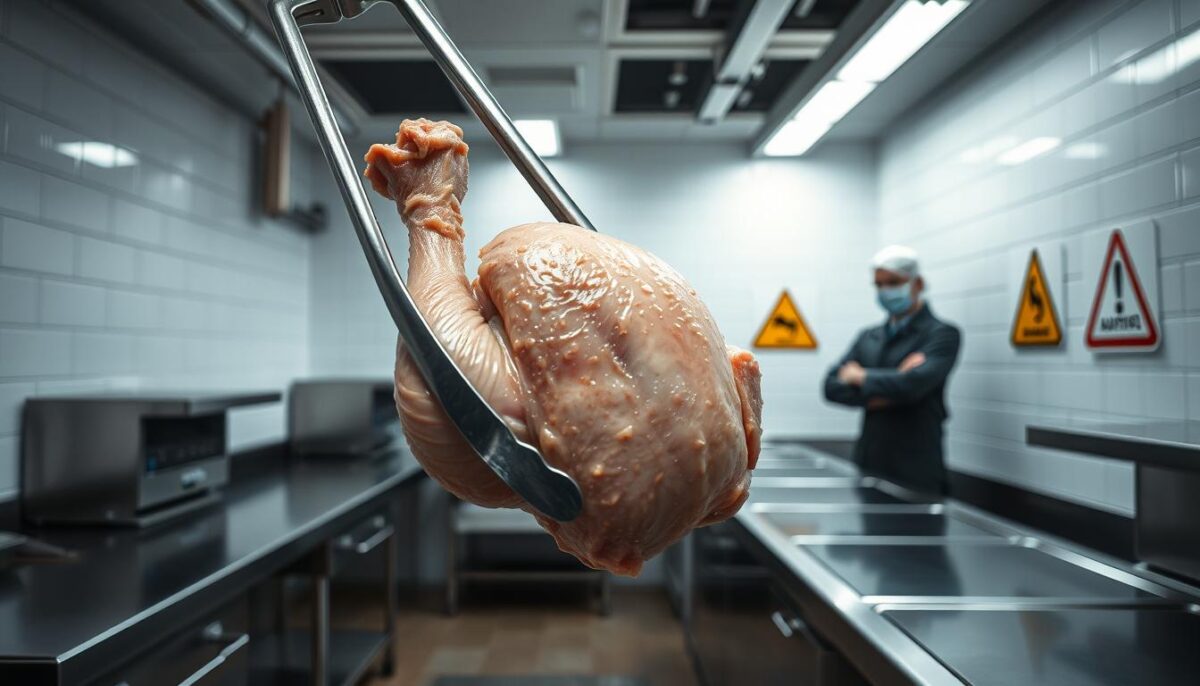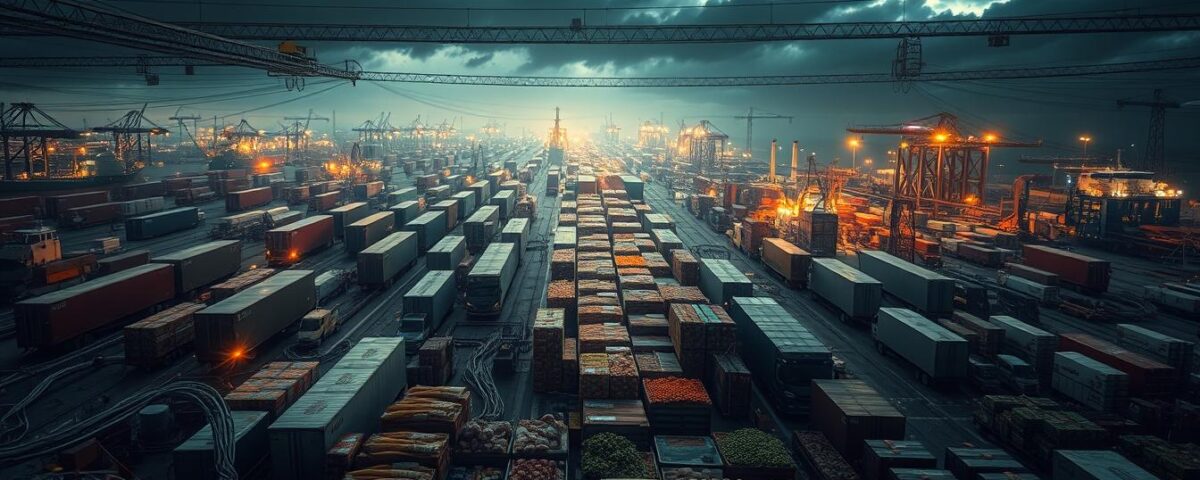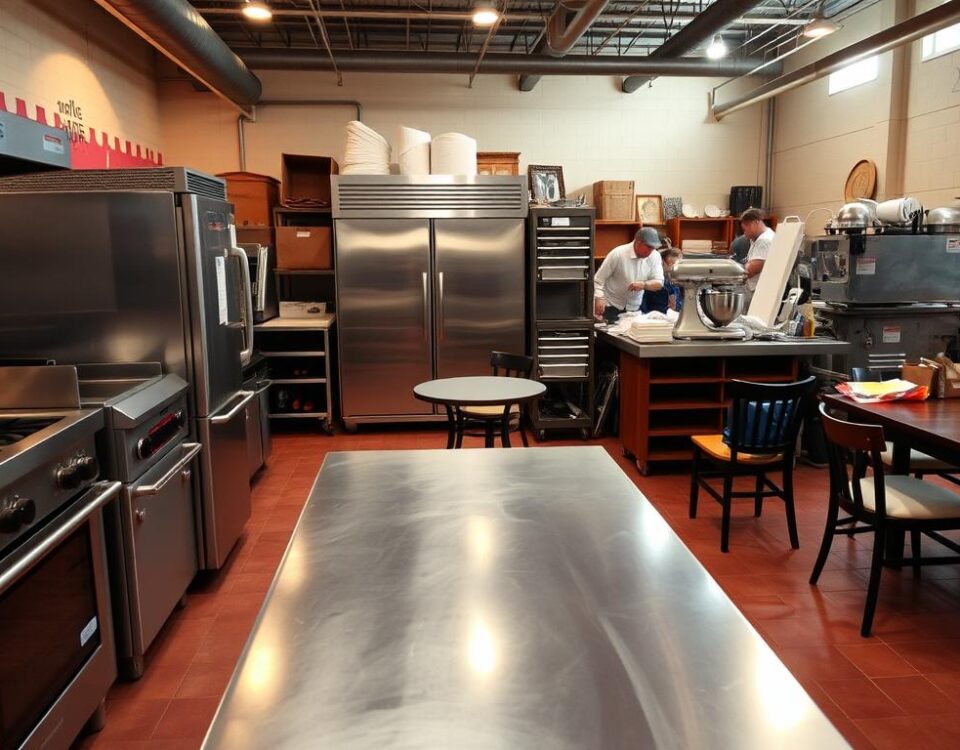
Best U.S. Food Distributors for Restaurants in 2025—Ranked
August 14, 2025
5 Golden Rules for Buying Wholesale Food for Your Restaurant
August 15, 2025As I navigated the complex world of food distribution for my business, I realized that choosing the right supplier is crucial to maintaining profitability. A recent experience with a delayed shipment not only increased my costs but also put my customer relationships at risk.
Today’s interconnected supply chains are prone to complications from weather events, geopolitical concerns, and skilled labor shortages, contributing to increased costs and risk exposure. In fact, a recent study revealed that companies can face potential cost increases of 15-30% if they’re not careful about who they partner with.
As the food industry continues to evolve, it’s essential to understand the risks associated with poor distribution partnerships, including damage to brand reputation and long-term business viability. Can you afford to let the wrong supplier decisions impact your business in 2025?
Key Takeaways
- Choosing the right distributor is crucial to maintaining profitability in the food industry.
- Poor distribution partnerships can lead to increased costs, damage to brand reputation, and long-term business viability.
- The food distribution landscape is changing rapidly, with new challenges emerging from supply chain disruptions and labor shortages.
- Hidden costs of working with the wrong supplier include emergency deliveries, product waste, and compliance issues.
- Identifying key risk factors in distributor selection can protect your business from financial impact.
The Hidden Costs of Poor Distribution Partnerships
As a food business owner, I need to be aware of the hidden costs associated with poor distribution partnerships. With higher costs and continued threats to both physical and digital supply chains, retailers, restaurants, and food and beverage companies require an agile mindset to identify and quickly address ever-evolving challenges.
Financial Impact on Your Bottom Line
Poor distribution partnerships can silently drain my profits through increased inventory carrying costs, emergency shipment fees, and product waste. I’ve found that these costs can add up to 5-8% of my total food costs. The financial impact extends beyond immediate costs to include lost sales opportunities, customer compensation, and potential brand damage.
Operational Disruptions That Drain Resources
When my supplier fails to deliver on time or with the right quality, I face operational disruptions that force me to pay premium prices for last-minute alternatives or disappoint my customers. This not only affects my cash flow but also leads to hidden administrative costs as my team spends valuable time resolving delivery issues and managing supplier communications.
Supply Chain Vulnerabilities That Increase Expenses
As I navigate the complexities of my food supply chain, I’ve come to realize that various vulnerabilities can significantly increase my expenses. Interconnected supply chains remain vulnerable to events anywhere in the world, whether it’s a natural disaster, geopolitical pressures, or other risks. It’s crucial for me to take both short- and long-term approaches to identify potential disruptors and build a resilient supply chain.
Weather Events and Geopolitical Disruptions
Extreme weather events and natural disasters can disrupt my food supply chain with little warning, causing price spikes of 20-40% for affected ingredients if my distributor lacks contingency plans. Geopolitical tensions and trade disputes can also create sudden tariffs or export restrictions that impact my food costs. A distributor with diversified sourcing can minimize these impacts, ensuring a more stable supply chain.
Labor Shortages and Transportation Bottlenecks
Labor shortages in transportation and warehousing are creating bottlenecks that lead to delayed deliveries and spoilage. A distributor without strong workforce management will pass these costs on to me. It’s essential to partner with a supplier who has effective labor management strategies in place to mitigate these risks and maintain a smooth supply chain.
Theft and Security Concerns
Cargo theft costs the food industry billions annually and can lead to significant inventory losses if proper protocols aren’t in place. I need to consider how my distributor handles security concerns. A reliable distribution partner will have invested in supply chain resilience strategies, including robust security measures, to protect my business from these vulnerabilities.
Food Safety Risks and Their Financial Consequences
Maintaining high standards of food safety is essential for protecting consumers and preserving the reputation and financial health of food businesses. The U.S. Food and Drug Administration (FDA) has emphasized the importance of supplier food safety management through the Food Safety Modernization Act (FSMA).

The financial stakes are high when it comes to food safety. Incidents can cost businesses between $10,000 and $30 million, with the average recall costing around $10 million in direct and indirect expenses. When a distributor has poor food safety practices, the business is exposed to significant liability risks, even if the contamination occurred in the distributor’s facility.
Contamination Issues and Recall Costs
Contamination issues can lead to costly recalls, which not only affect the bottom line but also damage brand reputation. The financial consequences of food safety failures include recall costs, legal fees, increased insurance premiums, lost sales, and brand rehabilitation expenses.
- Recall costs can be substantial, ranging from $10,000 to $30 million.
- Legal fees and increased insurance premiums add to the financial burden.
- Lost sales and brand rehabilitation expenses can impact businesses for years.
Regulatory Violations and Compliance Penalties
Regulatory violations from distributors can result in compliance penalties, which may be passed on to businesses through higher prices or disrupted supply if the distributor’s facility is temporarily shut down. Ensuring that distributors maintain proper temperature control throughout transportation and storage is crucial, as temperature abuse is a leading cause of foodborne illness and can lead to costly product waste.
Verifying a distributor’s compliance with food safety regulations is essential to mitigate these risks.
Wrong Food Distributor Risks: Visibility and Transparency Issues
A wrong food distributor can lead to a myriad of issues, including visibility and transparency problems in your supply chain. As I navigate the complexities of food distribution, I’ve come to realize that having the right level of visibility into my distributor’s operations is crucial for managing costs and ensuring operational efficiency.
Limited Supply Chain Visibility
Limited supply chain visibility can be a significant risk when dealing with a wrong food distributor. I’ve discovered that limited visibility into my distributor’s operations can prevent me from identifying potential problems before they affect my business, leading to surprise shortages and unexpected cost increases. To mitigate this risk, I need to prioritize distributors who offer digital platforms that provide complete visibility into order status, inventory levels, and pricing changes.
As Michael Dell once said, “The most important thing in technology is not the technology itself, but how it enables you to do things differently.” In the context of food distribution, this means leveraging technology to gain real-time insights into the supply chain.
- I’ve found that having a clear view into the products in my stores, restaurants, warehouses, or distribution centers helps to identify shortages or excesses and can also inform my insurance purchasing.
- The inability to track products through the supply chain in real-time means I can’t accurately predict delivery times or proactively address delays, forcing me to carry excess inventory as a buffer.
Lack of Transparent Communication
A lack of transparent communication from my distributor can create operational chaos that ultimately increases my food costs through inefficiency and waste. When my distributor lacks transparency about their sourcing practices, I can’t effectively communicate with my customers about the origin and quality of ingredients, which is increasingly important to today’s consumers.
To avoid these issues, I need to work with distributors who provide clear communication about pricing changes, product substitutions, or delivery issues. As Sun Tzu said, “The line between disorder and order lies in logistics.” Transparent communication is key to maintaining order in the supply chain.
“Transparency is not the same as clarity. It is the responsibility of the supplier to be transparent about their practices.”
By prioritizing distributors who offer transparent communication and digital platforms for visibility, I can mitigate the risks associated with a wrong food distributor and ensure a smoother, more efficient supply chain.
Forecasting Failures and Inventory Management Problems
Accurate forecasting is crucial for retailers, restaurants, and food and beverage companies to manage their inventory effectively. With tight budgets and short windows to deliver products, forecasting has become a lifeline, allowing companies to efficiently order sufficient amounts of products to accommodate customers’ shifting requirements.

Inaccurate Demand Predictions
I’ve found that distributors with poor forecasting capabilities often push excess inventory onto me to solve their own management problems, tying up my capital and increasing my spoilage rates. When my distributor can’t accurately predict demand patterns, I’m forced to either overstock (increasing my carrying costs and waste) or understock (risking stockouts and lost sales).
- A distributor who doesn’t share market intelligence or collaborate on demand planning leaves me vulnerable to sudden market shifts.
- I need a distribution partner who uses advanced analytics and has systems that integrate with mine to create accurate, collaborative forecasts.
Excess Inventory and Spoilage Costs
The financial impact of excess inventory is substantial—each dollar tied up in unnecessary inventory costs me approximately 25-30% annually in carrying costs, storage, and potential spoilage. This not only affects my bottom line but also diverts resources away from other critical areas of my business.
To mitigate these risks, it’s essential to partner with a supplier who can provide accurate forecasting and collaborative demand planning. By doing so, I can minimize excess inventory, reduce spoilage costs, and ensure that my products meet customer demand.
Technology Gaps That Amplify Distribution Costs
As a business owner, I’ve come to realize that technology gaps in distribution can significantly amplify costs. In today’s fast-paced business environment, staying ahead of the curve is crucial, and this includes leveraging the latest technology in our supply chains.
The food industry is particularly vulnerable to technology gaps, especially when it comes to tracking and monitoring systems. Outdated technology can lead to inefficiencies and increased costs.
Outdated Tracking and Monitoring Systems
I’ve realized that distributors using outdated technology can’t provide the real-time tracking and monitoring that helps me optimize my inventory and reduce waste, potentially costing me 3-5% in unnecessary food expenses. For instance, a distributor lacking temperature monitoring technology throughout the cold chain increases the risk of receiving compromised products that must be discarded, directly impacting my food costs.
To mitigate these risks, I need to evaluate whether my supplier is investing in technologies like blockchain for traceability, AI for demand forecasting, and IoT for condition monitoring. These innovations can significantly reduce my overall food costs and improve food safety.
Cybersecurity Vulnerabilities
Cybersecurity vulnerabilities in my distributor’s systems can lead to order disruptions, payment issues, or data breaches that create both immediate costs and long-term business damage. A distributor without integrated ordering systems forces my team to use manual processes that are error-prone and time-consuming, creating hidden labor costs and increasing the likelihood of expensive mistakes.
To address these concerns, I must assess the technology infrastructure of my distributors and ensure they are equipped to handle the demands of modern supply chains. By doing so, I can minimize risks and maintain a high level of quality and food safety in my products.

Distribution Partners That Can’t Scale With Your Business
As my business expands, I’ve come to realize that a distributor who can’t scale with me can be a significant liability. This is particularly concerning in the food and beverage industry, where supply chain flexibility is crucial. A reliable supplier should be able to adapt to changing demands, ensuring that my products reach customers efficiently.
Inflexible Capacity During Peak Seasons
During peak seasons, I’ve discovered that distributors with capacity constraints can force me to use multiple suppliers, increasing my administrative costs and complexity. This not only reduces my volume discounts but also complicates my supply chain management. To avoid this, I need to assess whether my distribution partner has the operational flexibility to handle seasonal fluctuations.
- A distributor with inflexible capacity can limit my ability to capitalize on high-demand periods.
- Using multiple suppliers can lead to inconsistent customer experiences and increased operational risks.
Inability to Support Business Growth
When my business grows, but my distributor can’t scale their services accordingly, I face disruptions that can cost me customers and revenue. To mitigate this risk, I must evaluate whether my distribution partner has the financial stability, infrastructure, and strategic vision to support my business growth plans for the next 3-5 years.
- I need to assess the distributor’s ability to expand into new geographic areas alongside my business.
- A scalable distribution partner should be able to handle special promotions and seasonal fluctuations without disrupting my operations.
By choosing a distribution partner that can scale with my business, I can ensure a more efficient supply chain and better customer satisfaction. This, in turn, supports my company’s long-term growth and profitability in the competitive food and beverage industry.
How to Identify and Avoid Problematic Distributors
To avoid costly mistakes, it’s essential to know how to identify red flags when evaluating potential food distributors. A thorough assessment can save businesses from significant losses down the line.
Key Warning Signs During Vendor Assessment
When assessing potential distributors, there are several warning signs to watch out for. Frequent staff turnover, outdated facilities, and a reluctance to provide references are all indicators of potential problems. I should also review their food safety certifications, FSMA compliance documentation, and recent health inspection reports to identify any risks.
- Request and review food safety certifications to ensure compliance.
- Check for FSMA compliance documentation.
- Review recent health inspection reports.
Essential Questions to Ask Potential Partners
Asking the right questions can reveal a lot about a distributor’s capabilities and resilience. I should inquire about their contingency plans for supply disruptions, technology investments, and financial stability. Visiting their facility in person is also crucial to observe their operations and storage conditions.
| Question | Purpose |
|---|---|
| What are your contingency plans for supply disruptions? | Assess their ability to handle unexpected issues. |
| How do you invest in technology? | Evaluate their commitment to innovation and efficiency. |
| Can you share your financial stability reports? | Understand their financial health and reliability. |
Conclusion: Securing Your Food Costs Through Smart Distribution Choices
As I prepare my business for the challenges of 2025, I’m focusing on building a strong partnership with a reliable food distributor. With over 20 years of experience and a portfolio of 500+ white-label drinks success-proven in 5 continents and 50+ countries, I’ve learned that the right supplier is crucial for navigating supply chain complexities.
By carefully evaluating potential distributors, I can avoid costly mistakes that many food businesses face in 2025. The right partner will help me control costs, maintain consistent food safety, and ensure customer satisfaction. I need to prioritize distribution partners who demonstrate transparency, technological capability, and the capacity to grow alongside my business.
Selecting the right supplier is an investment that will pay dividends through lower overall costs, fewer disruptions, and better inventory management. As I move forward, I’ll remember that the lowest quoted price rarely represents the true cost of working with a distributor. By prioritizing food safety and quality assurance, I can secure my food costs for the long term.
FAQ
What are the key factors to consider when selecting a food distributor to minimize supply chain risks?
When choosing a food distributor, I consider their quality assurance processes, supply chain visibility, and compliance with regulations like the Food Safety Modernization Act (FSMA) to ensure a reliable partnership.
How can a distributor’s lack of transparency affect my business operations?
A distributor’s lack of transparency can lead to inventory management problems, forecasting failures, and increased costs due to unforeseen issues, ultimately impacting my bottom line.
What are the potential financial consequences of a food safety risk in my supply chain?
A food safety risk can result in costly recalls, regulatory penalties, and damage to my brand’s reputation, ultimately affecting my revenue and profitability.
How can I assess a potential distributor’s ability to scale with my growing business?
To evaluate a distributor’s scalability, I assess their capacity during peak seasons, flexibility in logistics, and ability to support business growth to ensure they can meet my evolving needs.
What role does technology play in modern food distribution, and how can outdated systems impact my business?
Technology plays a crucial role in food distribution, and outdated tracking and monitoring systems can lead to inefficiencies, cybersecurity vulnerabilities, and increased costs, ultimately affecting my competitiveness.
What are some warning signs that a distributor may not be a good fit for my business?
Some red flags include limited supply chain visibility, poor communication, and inflexible capacity, which can indicate a distributor’s inability to meet my business needs.
How can I ensure my distributor prioritizes employee hygiene and safety in their operations?
I look for distributors who emphasize employee hygiene and have robust safety protocols in place to minimize the risk of contamination and ensure a safe working environment.



